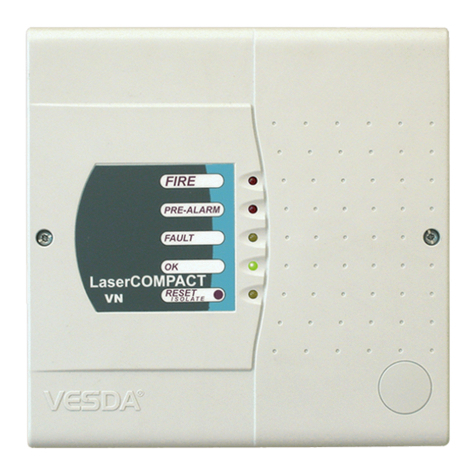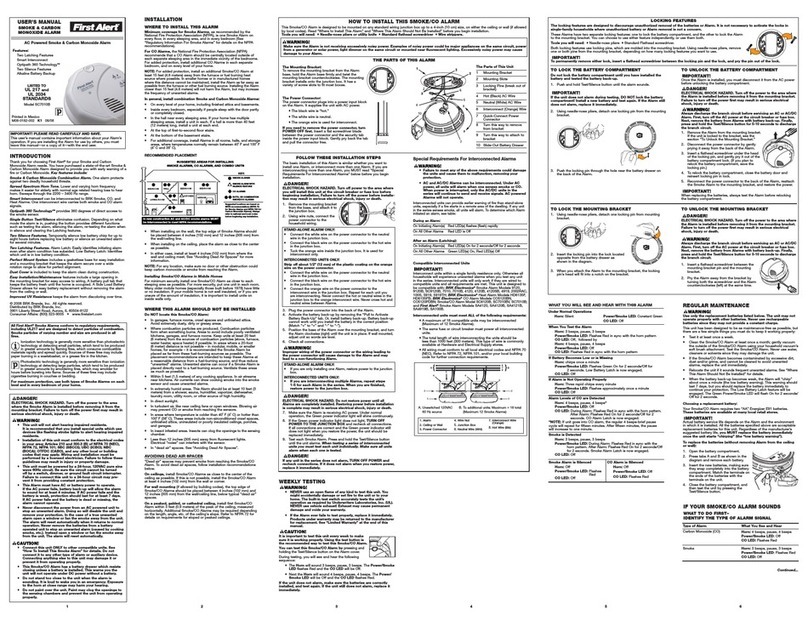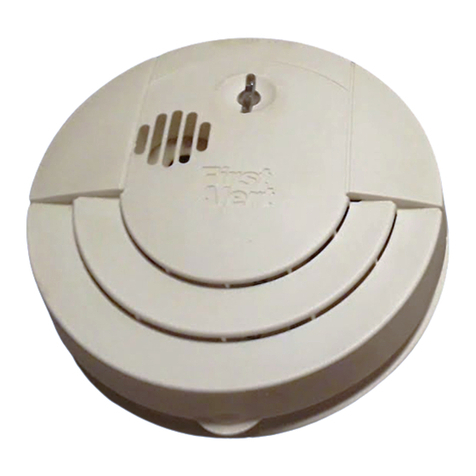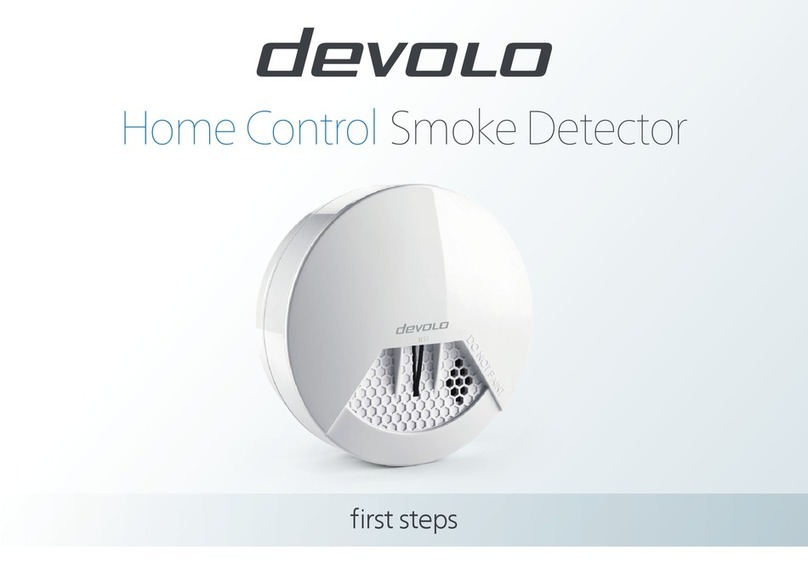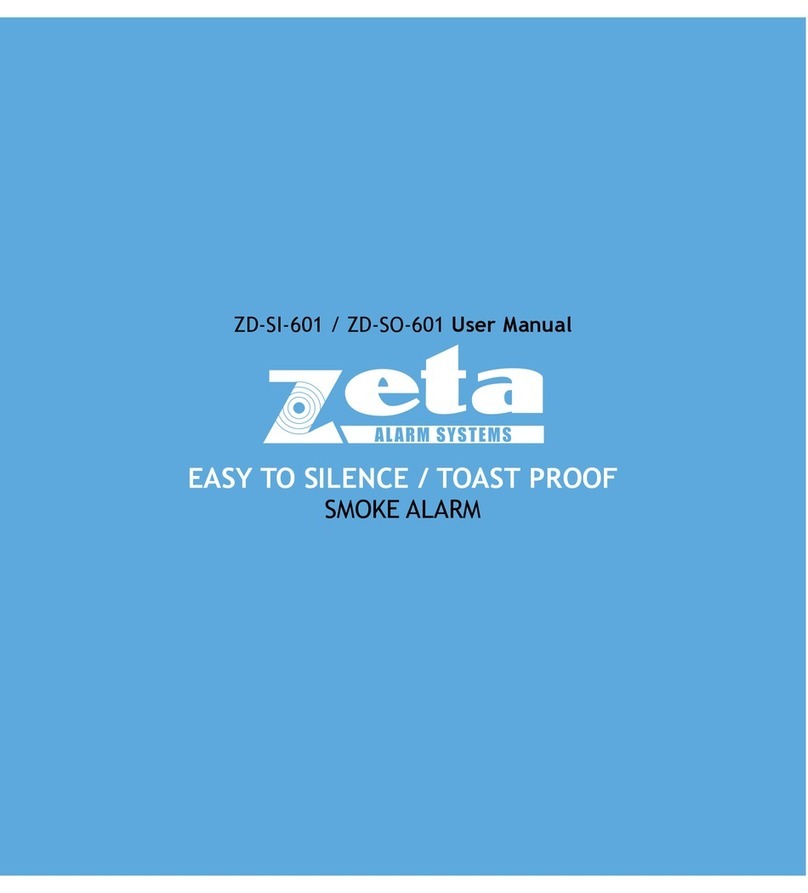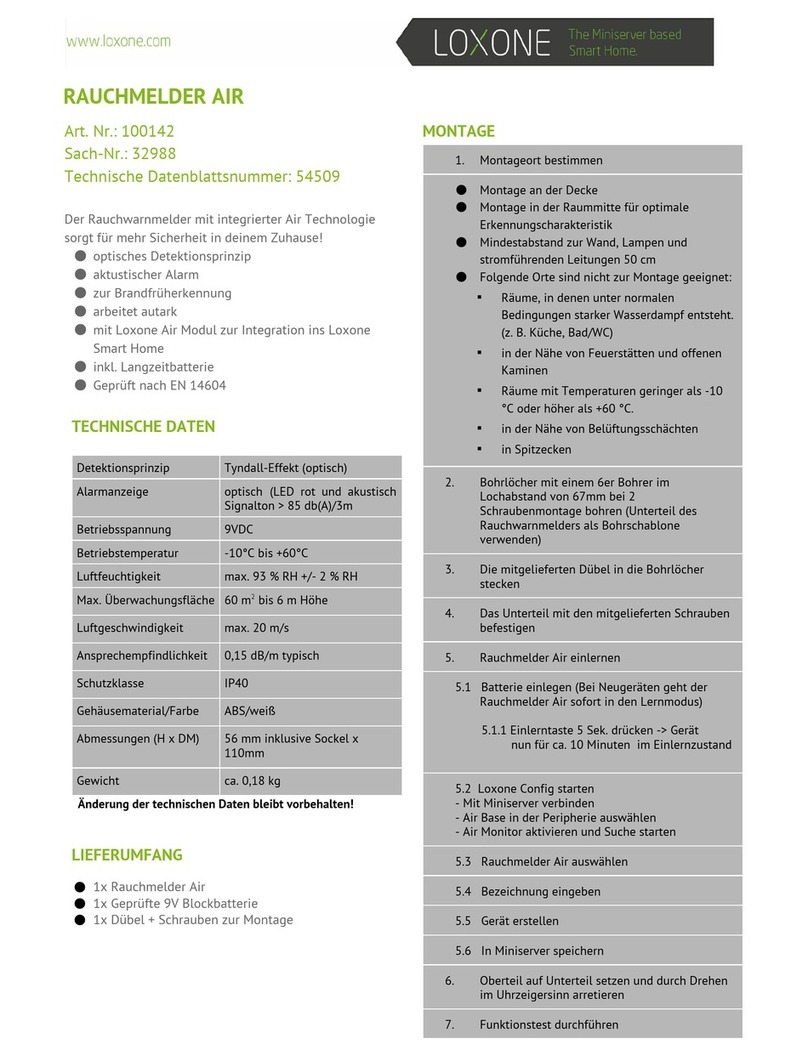Crow FW2-SMK User manual

1
2
3
FW2-SMK
TWO WAY WIRELESS
SMOKE DETECTOR
INSTALLATION INSTRUCTIONS
P/N 7102316 REV. B (D.Z.)
INTRODUCTION
The FW2-Smoke detector is an advanced, fully
supervised low-current wireless detector that
includes a FW2 transceiver for reliable system
operation.
The FW2-Smoke detector includes special
chamber structure for best smoke detection
performances.
The FW2-Smoke detector uses smart message
control, which verifies that all messages are
successfully transmitted, so that no smoke or any
other event will be uninformed to the base.
The FW2-Smoke detector includes series of
messages for full communication administration
(Supervision, Tamper Status, Battery Status, Alert,
etc.) as well as test transmission signals.
FEATURES
Freewave FW2 ISM protocol.
Low current Technology.
Powered by 3V Lithium battery pack.
Battery life: >10 years.
Audible Warning by a built-in horn (three beeps)
in Test mode or Alarm.
Frequency Band: 868.35MHz or 916.5MHz.
Tamper Open/Close transmission.
Supervision transmission.
Battery status transmission.
Bi-Color LED indications.
Range up to 500m on open space.
4
5
6
OPERATION
This FW2-Smoke detector transmits the
following events data:
SUPERVISION –A periodical transmission
(configurable) indicating detector’s presence.
ALARM –Alarm transmission triggered by the
device indicating Smoke detection. The Red LED
will blink once.
LOW BAT –Whenever the battery reaches the
low level (2.5V), a Battery Low signal will be sent.
When Battery level drops below Cut Off level
(2.3V) the device will stop functioning and the Red
LED will blik for 10 seconds and then turned Off.
TAMPER –Whenever the cover is removed from
Bracket or the device is tear off from the celling, a
message will be transmitted with “Tamper ON”
signal. When the device will be returned to its
place a “Tamper OFF” signal will be transmitted.
INSTALLATION LOCATIONS
Smoke detectors shall be installed in accordance
with NFPA Standard 74. Here are few useful tips
for complete coverage in residential units:
Install a smoke detector in the hallway outside
every separate bedroom area. Two detectors
are required in homes with two bedroom areas.
Install a smoke detector on every floor of multi-
floor home or apartment.
Install a minimum of two detectors in any
household.
Install a smoke detector inside every bedroom.
Install smoke detectors at both ends of bedroom
hallway if hallway is more than 12m (40ft) long.
Install a smoke detector inside every room where
one sleeps with the door partly or completely
closed, since smoke could be blocked by the
closed door and a hallway alarm may not wake
up the sleeper if the door is closed.
Install basement detectors at the bottom of the
basement stairwell.
INSTALLATION LOCATIONS (Continue)
Install second-floor detectors at the top of the
first-to-second floor stairwell.
Be sure no door or other obstruction blocks the
path of smoke to the detector.
Install additional detectors in your living room,
dining, family, attic, utility and storage rooms.
Install smoke detectors as close to the center of
the ceiling as possible. If this is not practical, put
the detector on the ceiling, at least 10 cm (4 inch)
away from any wall or corner.
If ceiling mounting is not possible and wall
mounting is permitted by your local and state
codes, the wall-mounted detectors shall be
installed between 10cm to 15cm (4 - 6 inches)
from the ceiling.
If some of your rooms have sloped, peaked, or
gabled ceilings, try to mount detectors 0.9 m
(3feet) measured horizontally from the highest
point of the ceiling.
7
8
9
WRONG INSTALLATION LOCATIONS
False alarms occur when smoke detectors are
installed where they will not work properly. To
avoid false alarms, do not install smoke detectors
in the following situations:
Combustion particles are by-products of
something burning. Do not install smoke
detectors in or near areas where combustion
particles are present, such as kitchens with poor
ventilation, garages where there may be vehicle
exhaust, near furnaces, hot water heaters and
space heaters.
Do not install smoke detectors less than 6 m (20
feet) away from places where combustion
particles are normally present. If a 6 m (20 feet)
distance is not possible try to install the detector
as far away from the combustion particles as
possible, preferably on the wall. To prevent false
alarms, provide good ventilation in such places.
WRONG INSTALLATION LOCATIONS
The path of fresh air intake. The flow of fresh
air in and out can drive smoke away from the
smoke detector; thus reducing its efficiency.
In damp or very humid areas or near
bathrooms with showers. Moisture in humid air
can enter the sensing chamber, then turns into
droplets upon cooling, which can cause
nuisance alarms. Install smoke detectors at
least 3 m (10 feet) away from bathrooms.
In very cold or very hot areas, including
unheated buildings or outdoor rooms. If the
temperature goes above or below the operating
range of smoke detector, it will not work
properly.
In very dusty or dirty areas, dirt and dust can
build up on the detector’s sensing chamber, to
make it overly sensitive. Additionally, dust or dirt
can block openings to the sensing chamber
and keep the detector from sensing smoke.
WRONG INSTALLATION LOCATIONS
Near fresh air vents or very drafty areas like air
conditioners, heaters or fans. Fresh air vents
and drafts can drive smoke away from smoke
detectors.
In “Dead Air” spaces like at the top of a peaked
roof, or in the corners between ceilings and
walls. Dead air may prevent smoke from
reaching a detector.
In insect-infested areas. If insects enter a
detector’s sensing chamber, they may cause a
nuisance alarm. Where bugs are a problem, get
rid of them before installing the detector.
Near fluorescent lights, electrical "noise" from
fluorescent lights may cause nuisance alarms.
Install smoke detectors at least 1.5 m (5 feet)
from such lights.
10
11
12
PAIRING PROCESS
1. Separate the Smoke from its bracket by
rotating the device counterclock wise.
2. If not done so before, shortly press the Pairing
button to power up the device. This activity
shall be done only once during the product life
time.
3. Wait until the Red LEDs stops blinking.
4. Refer to your control panel manual for learning
mode procedure.
5. When registration process is successfully
completed the Green LEDs will
constantly light On for 3 seconds and
then turn Off.
6. If registration process failed the Red
LEDs will blink. wait for few seconds
(~10sec) and repeate the pairing process
from step 4 above.
TESTING THE DEVICE
ALARM TEST
Press shortly the "Test" button (See Figure 4) -
the smoke detector shall respond with "Bip-Bip-
Bip" sound, indicating that the device is in the
normal mode. If the test fails, stop using the
detector immediately.
WARNING
DON’T TEST IT WITH FIRE !!!
TAMPER TRANSMISSION TEST
Attaching / Removing the device to / from its
bracket will cause tamper transmissions. Verify
receiving the indication on your Application / Base.
IDENTIFICATION TRANSMISSION TEST
Use your Application / Base to send
Identification Request to the Smoke. The
Smoke will blinking the Green & Red LEDs
alternately –5 times.
FIGURE 1 –PAIRING BUTTON

13
14
15
MOUNTING THE DETECTOR
1. Hold the mounting bracket against the ceiling
and mark the center of each slot. Drill 2 holes
and install the barcket with the screws –Fig 2
2. Verify the Smoke detector is learned into the
control panel by pressing the Tamper button
(see below Figure) and verify receiving suitable
message in the Base.
3. Push the Smoke detector toward the bracket
and turn it clockwise to adjust the detector to
the bracket –see Figure 3.
FIGURE 2 –DETECTOR MOUNTING
FIGURE 3 –DETECTOR MOUNTING
16
17
18
FIGURE 4 –THE TEST BUTTON
REGULAR MAINTENANCE –CLEANING
Never use water, cleaners or solvents to clean
your smoke alarm since they may damage the
unit. Use a soft brush only.
Remove the Smoke detector from its bracket and
carefully remove any dust from the Smoke’s
openings around the device (see below Figure) at
least once a year.
LIMITATIONS OF SMOKE ALARMS
1. United States NFPA72 tells that the safety of
life is to be noticed by alarms before fire, to
confirm the correct escape way. The fire
systems help half of residents escape. Help to
old people, women and children shall be given
since they are always the victims.
2. Smoke alarms are not foolproof, they can’t
prevent or extinguish fires, and they are not a
substitute for property or life insurance. You
need buy some firefighting facilities.
3. Sometimes the smoke is blocked by objects
and can’t reach the detector, and if the wind
blows the smoke away from the detector, the
unit won’t work either.
19
20
21
REGULATORY APPROVALS
The FW2-SMK conforms to the essential requirements set
out by:
EMC directive:2014/30/EU
LVD directive: 2014/35/EU
RE directive (RED): 2014/53/EU
RoHS2 directive: 2011/65/EU
Harmonized Standards applicable to these product are:
EN 301 489-3: V1.6.1(13)/V2.1.1(17)
EN 50130-4: 2011/A1(14)
EN 61000-6-3:2007/A1(11)/AC(12)
EN 301 489-1: V1.9.2(11)/V2.1.1(17)
EN 300 220-2: V3.1.1(17)
EN 60950-1:2006/A11(09)/A1(10)/A12(11)/A2(13)
IEC60950-1:2005/A1(09)/A2(13)
EN 14604:2005/A1(08)
TECHNICAL SPECIFICATIONS
RF Protocol FREEWAVE 2 ISM
Modulation Type GFSK
Frequency 868.35MHz or 916.5MHz
Event Transmission Alarm, Tamper, Supervision,
Battery status.
Detection Sensitivity: EN standard 0.125±0.075 dB/m
Alarm Sound Level: 85 db at 3 m (10 feet)
Range in open space >500m
Battery Pack of 2 Lithium 3V, Size: AA.
Battery life >10 years
Current Consumptions:
Standby 5A
Average 15µA (1 Keep Alive per Hour)
Maximum (TX) 400mA
Low Battery 2.5VDC
Cut Off Battery 2.3VDC
Transmit Power (Typ.): 23dBm
Tamper Switch Back Tamper
Operating temperature -10C to +55C
Dimensions 125mm diameter x 37mm deep
Weight (inc. battery) 235 gr.
WARNING!!!
CHANGES OR MODIFICATIONS TO THIS
EQUIPMENT NOT EXPRESSLY
APPROVED BY THE PARTY
RESPONSIBLE FOR COMPLIANCE
(CROW ELECTRONIC ENGINEERING
LTD.) COULD VOID THE USER’S
AUTHORITY TO OPERATE THE
EQUIPMENT.
22
22
23
24
FCC & IC
STATEME
NT
FCC ID:
NF
C-CRDU
IC:
816
4A- CRDU
This device
complies with
FCC Rules Part
15 and with
Industry
Canada license-
exempt RSS
standard(s).
Operation is
subject to two
conditions: (1)
This device may
not cause
harmful
interference,
and (2) this
device must
accept any
interference that
FCC & IC
STATEME
NT
(Continue
)
Operation is
subject to the
following two
conditions: (1)
this device may
not cause
interference,
and (2) this
device must
accept any
interference,
including
interference that
may cause
undesired
operation of the
device.
Conformément
à la
réglementation
d'Industrie
Canada, le
FCC & IC
STATEME
NT
(Continue
)
Note: The
digital circuit
of this device
has been
tested and
found to
comply with
the limits for a
Class B digital
device,
pursuant to
part 15 of the
FCC Rules.
These limits
are designed
to provide
reasonable
protection
against
harmful
interference in
a residential
23
24
CROW ELECTRONIC ENGINEERING LTD. ("Crow") - WARRANTY POLICY CERTIFICATE
This WarrantyCertificate is given in favor ofthe purchaser (hereunder the "Purchaser") purchasing the products directlyfrom Crow or from its
authorized distributor.
Crow warrants these products to be free from defects in materials and workmanship under normal use and service for a period of 24 months from the
last dayof the week and year whose numbers are printed on the printed circuit board inside these products (hereunder the "Warranty Period").
Subject to the provisions of this WarrantyCertificate, during the WarrantyPeriod, Crow undertakes, at its sole discretion and subject to Crow's
procedures,as such procedures are form time to time, to repair or replace, free of charge for materials and/or labor, products proved to be defective in
materials or workmanship under normal use and service. Repaired products shall be warranted for the remainder of the original Warranty Period.
All transportation costs and in-transit risk ofloss or damage related, directly or indirectly, to products returned to Crow for repair or replacement shall
be borne solelyby the Purchaser.
Crow's warranty under this WarrantyCertificate does not cover products that is defective (or shall become defective) due to: (a) alteration of the
products (or anypart thereof) byanyone other than Crow; (b) accident, abuse, negligence, or improper maintenance;(c) failure caused bya product
which Crow did not provide; (d) failure caused bysoftware or hardware which Crow did not provide;(e) use or storage other than in accordance with
Crow’s specified operating and storage instructions.
There are no warranties,expressed or implied, of merchantability or fitness of the products for a particular purpose or otherwise, which extend beyond
the description on the face hereof.
This limited WarrantyCertificate is the Purchaser's sole and exclusive remedyagainst Crow and Crow's sole and exclusive liability toward the
Purchaser in connection with the products, including without limitation - for defects or malfunctions of the products.This Warranty Certificate replaces
all other warranties and liabilities, whether oral, written, (non-mandatory) statutory, contractual, in tort or otherwise.
In no case shall Crow be liable to anyone for anyconsequential or incidental damages (inclusive of loss of profit,and whether occasioned by
negligence of the Crow or anythird partyon its behalf) for breach ofthis or any other warranty,expressedor implied, or upon any other basis of liability
whatsoever. Crow does not represent that these products can not be compromised or circumvented; that these products will prevent any person injury
or property loss or damage byburglary, robbery, fire or otherwise; or that these products will in all cases provide adequate warning or protection.
Purchaser understands that a properly installed and maintained product may in some cases reduce the risk of burglary, fire, robberyor other events
occurring without providing an alarm, but it is not insurance or a guarantee thatsuch will not occur or thatthere will be no personal injury or property
loss or damage as a result.
Consequently, Crow shall have no liabilityfor any personal injury; propertydamage or any other loss based on claim that these products failed to give
any warning.
IfCrow is held liable, whether directlyor indirectly, for anyloss or damage with regards to these products, regardless of cause or origin, Crow’s
maximum liability shall not in anycase exceed the purchase price of these products, which shall be the complete and exclusive remedy against Crow.
sales@crow.co.il
support@crow.co.il
www.thecrowgroup.com
These instructions supersede all previous issues in circulation prior to
December 2017
OPENINGS
Popular Smoke Alarm manuals by other brands
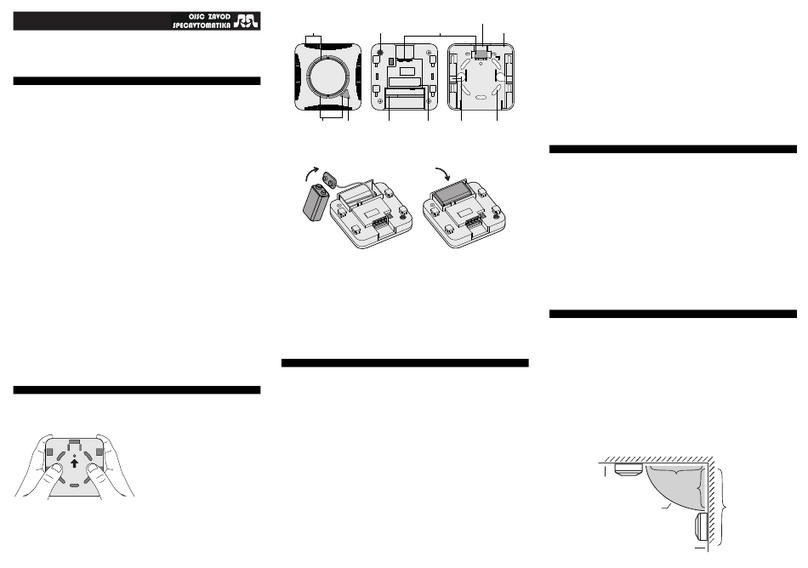
SPECAVTOMATIKA
SPECAVTOMATIKA DOKA Instruction
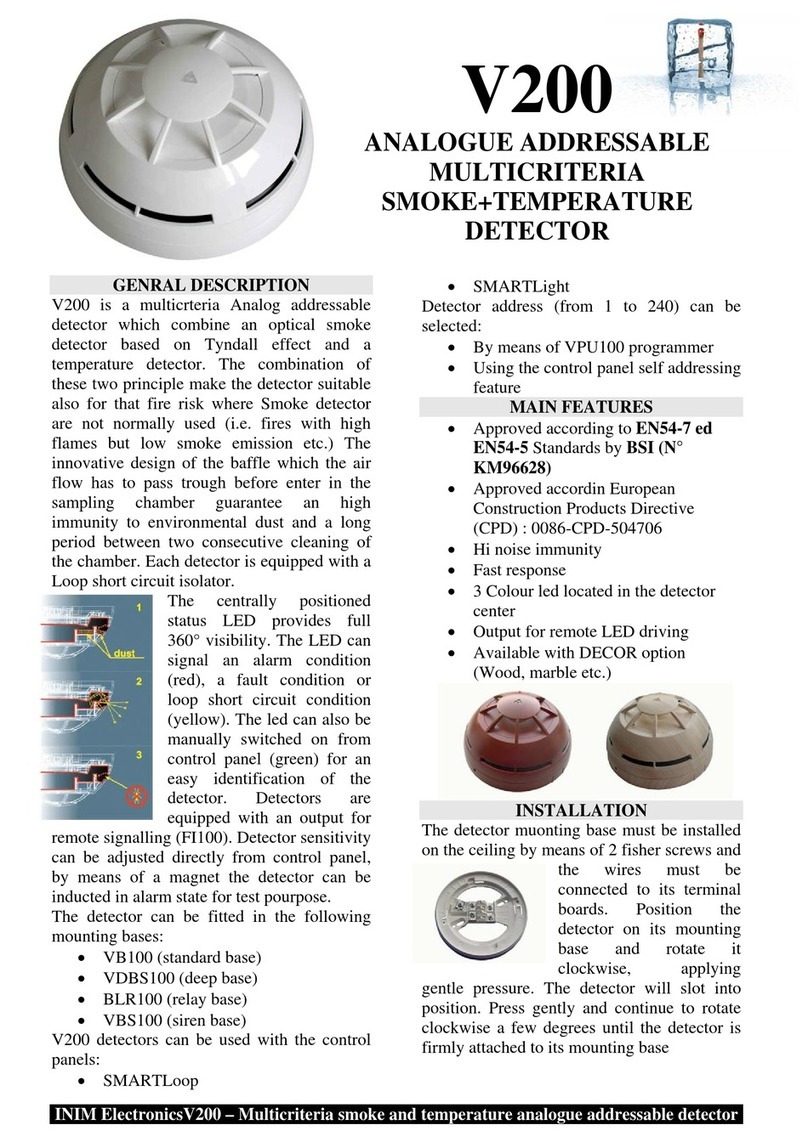
INIM Electronics
INIM Electronics V200 quick start guide

Det-Tronics
Det-Tronics SmokeWatch U5015 instructions
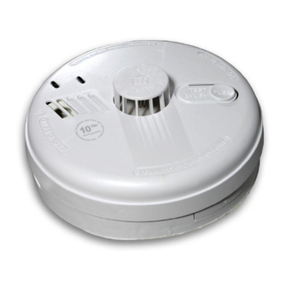
Ei Electronics
Ei Electronics Ei161RC Ionisation installation instructions
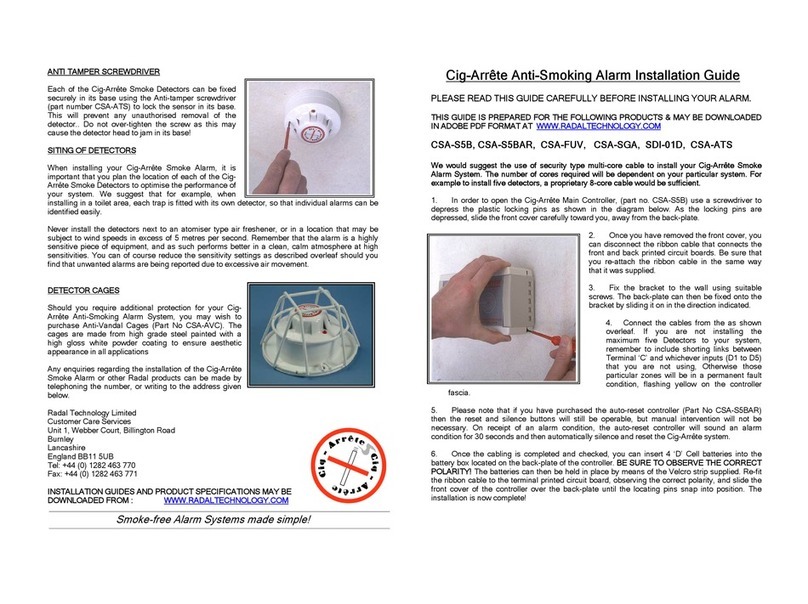
Radal Technology
Radal Technology CSA-S5B installation guide
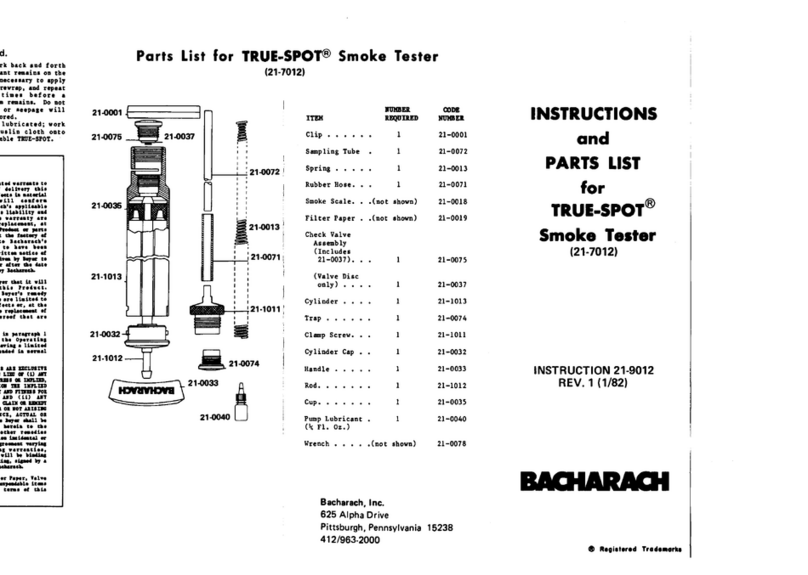
Bacharach
Bacharach True-Spot 21-7012 Instructions and parts list
